Otaku Talk
Definition of otaku, mania, moe, dame, anime, and generations
This transcript has been prepared from a PDF scan of pg164–185 of Little Boy: The Arts of Japan’s Exploding Subculture, ed. Murakami, published 2005-05-15, ISBN 0300102852. The discussion took place on 2004-03-31. (See also the transcript “Earth In My Window” by Takashi Murakami.)
An earlier partial copy of this discussion appears online; it omits most of the images, and everything after the section Generational Debate.
**
to hide apparatus like the links, you can use reader-mode ().
Otaku Talk
by Toshio Okada & Kaichiro Morikawa; moderated by Takashi Murakami, and translated & annotated by Reiko Tomii
[pg165]
[Figure opposite: From DiGiCharat 199926ya TV anime series]
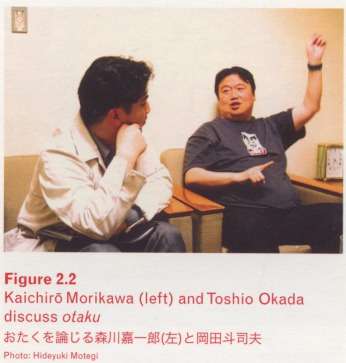
Figure right bottom: Kaichiro Morikawa (left) and Toshio Okada discuss otaku
Takashi Murakami: Okada-san, Morikawa-san, thank you for coming. Our topic today is the culture of otaku1 [literally, “your home”]. After Japan experienced defeat in World War II, it gave birth to a distinctive phenomenon, which has gradually degenerated into a uniquely Japanese culture. Both of you are at the very center of this otaku culture.
Let us begin with a big topic, the definition of otaku. Okada-san, please start us off.
Toshio Okada: Well, a few years ago, I declared, “I quit otaku studies,” because I thought there were no longer any otaku to speak of.
Back then [during the 1980s and early 1990s], there were a hundred thousand, or even one million people who were pure otaku—100-proof otaku, if you will. Now, we have close to ten million otaku, but they are no more than 10- or 20-proof otaku. Of course, some otaku are still very otaku, perhaps 80 or 90 proof. Still, we can’t call the rest of them faux otaku. The otaku mentality and otaku tastes are so widespread and diverse today that otaku no longer form what you might call a “tribe.” [zoku –Editor]
[pg166]
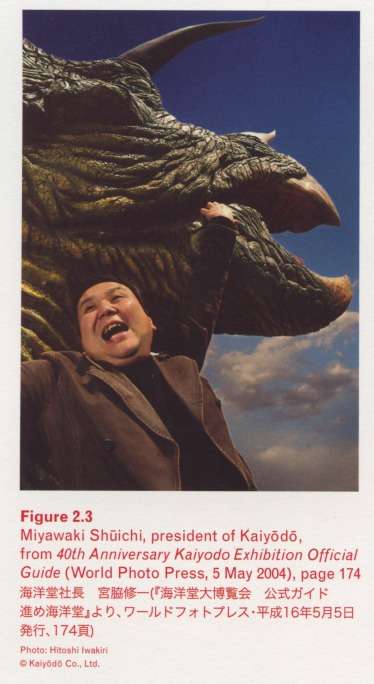
Figure top left: Miyawaki Shuichi, president of Kaiyodo, from 40th Anniversary Kaiyodo Exhibition Official Guide (World Photo Press, 2004-05-05), page 174
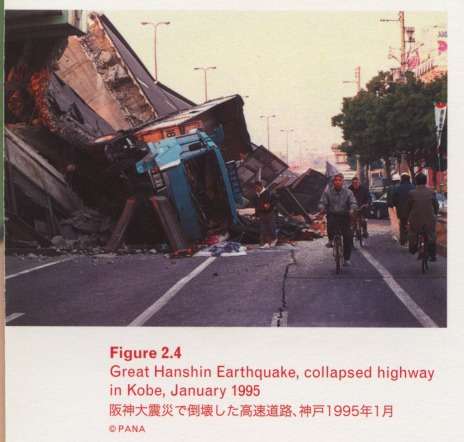
Figure bottom left: Great Hanshin Earthquake, collapsed highway in Kobe, January 1995
Kaichiro Morikawa: Okada-san’s definition of otaku sounds positive, as if they’re quite respectable.
In my opinion, otaku are people with a certain disposition toward being dame2 [“no good” or “hopeless”]. Mind you, I don’t use this word negatively here.
To some extent, people born in the 1960s are saddled with the baggage of an “anti-establishment vision.” In contrast, otaku, especially in the first generation, have increasingly shed this anti-establishment sensibility.
It’s important to understand that although otaku flaunt their dame-orientation—an orientation toward things that are no good—it’s not an anti-establishment strategy. This is where otaku culture differs from counterculture and subculture.
T. Murakami: Indeed, otaku are somewhat different from the mainstream. They have a unique otaku perspective, even on natural disasters. For example, the reaction of Kaiyodo’s3 executive, Miyawaki Shuichi, to witnessing the destruction of the Great Hanshin Earthquake4 in 199530ya was, “I know it’s insensitive to say this [after such terrible disaster], but I think Gamera5 got it wrong.” You know, the aftermath of a real earthquake was used as a criterion in otaku criticism.
T. Okada: At the time of the earthquake, I raced to Kobe from Osaka, hopping on whatever trains were still running, taking lots of pictures. I agree, Gamera got it wrong. To create a realistic effect of destruction, you need to drape thin, gray noodles over a miniature set of rubble. Otherwise, you can’t even approach the reality of twisted, buckled steel frames. It was like, “If you call yourself a monster-filmmaker, get here now!”
When Mt. Mihara6 erupted in 198639ya, the production team of the 1984 Godzilla film went there to see it.7 They were true filmmakers.
Wabi-Sabi-Moe
Takashi Murakami: Morikawa-san will present an exhibition about otaku and moe8 [literally, “bursting into bud”] at the architecture bienniale in Venice in 200421ya.9 Your association of otaku with architecture is unique. Please tell us about it.
[pg167]
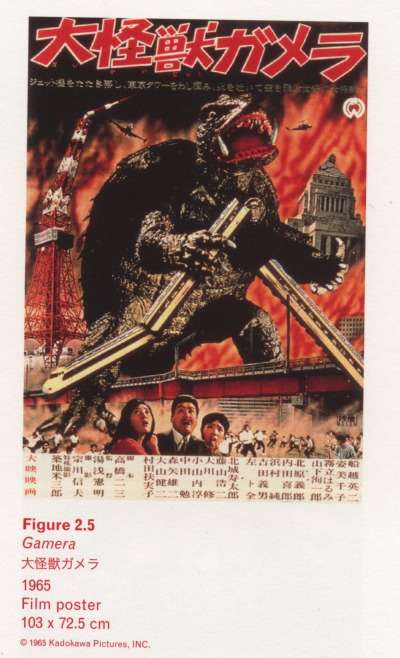
Figure top right: Gamera 196560ya Film poster 103
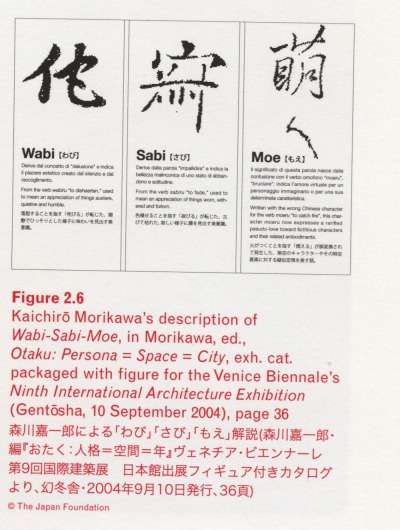
Figure bottom right: Kaichiro Morikawa’s description of Wabi-Sabi-Moe, in Morikawa, ed., Otaku: Persona = Space = City, exh. cat. packaged with figure for the Venice Biennale’s Ninth International Architecture Exhibition (Gentosha, 2004-09-10), page 36
Toshio Okada: I was most impressed by your phrase, wabi-sabi-moe, in the exhibition thesis.
Moe is not an easy concept to comprehend, but when you linked the three ideas linguistically, it made a lot more sense.
Those who are unfamiliar with the concepts of wabi and sabi [meaning “the beauty and elegance of modest simplicity”] must surely wonder what’s appealing about feigning poverty.
Likewise, with moe, until you get the concept, I’m sure people question the origins of this seeming obsession with beautiful little girls, bishojo.10 But once you get it, you start to feel like moe might become a megaconcept, exportable like wabi and sabi.
Kaichiro Morikawa: The truth is, I made up that phrase to pitch the show. But suddenly it was a headline in the Yomiuri newspaper.
T. Okada: That’s awesome. The fact that it became a headline means everybody can understand it.
K. Morikawa: It’s a play on something the architect Arata Isozaki11 did in his exhibition, Ma,12 in Paris in 197847ya. He provided logical English explanations for such traditional concepts as wabi and suki [meaning “sophisticated tastes”] on exhibition panels.
The key Japanese words—such as wabi, sabi, and suki—were inscribed in classical calligraphy and accompanied by lengthy English explanations printed in Gothic fonts.
I decided I’d do the same with moe.
There is a huge gap between people who know the word moe and those who don’t. Every otaku person knows moe. For them, it’s so basic. But it’s not like all young people know the term. While at graduate school, I asked my colleagues about moe but almost none of them knew it.
It dawned on me that most mainstream people just don’t know it.
T. Murakami: That disparity is really intriguing.
KM: It clearly corresponds with another gap between those who know that Akihabara13 is now an otaku town and those who don’t.
Those who do know couldn’t care less that others
[pg168]
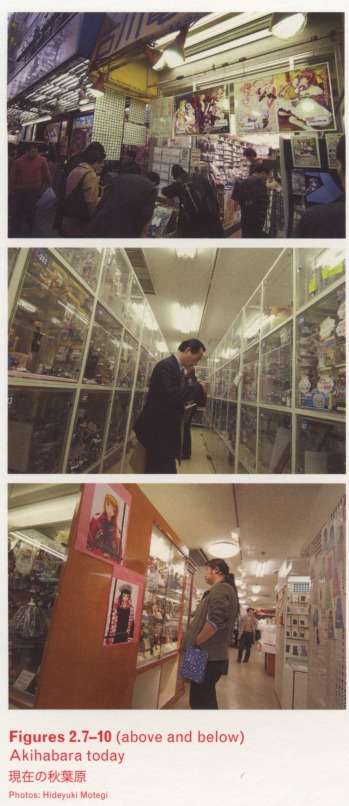
Figure top left: (above and below) Akihabara today

Figure bottom left: (above and below) Akihabara today
are finally catching up, while those who don’t know
Akihabara today still think of Akihabara the way it’s been portrayed in commercials for household-appliance stores. This gap reflects the state of Japanese culture and society today.
To those who are unfamiliar with moe, I only half-jokingly explain, “In the past, we introduced foreigners to such indigenous Japanese aesthetic concepts as wabi and suki. These days, people abroad want to know all about moe.” A lot of people respond, “Oh, is that so…”
TM: Morikawa-san, I’d like to ask you, then: What prompted otaku to gather in Akihabara?
KM: Otaku are self-conscious about being condescended to, when they go to fashionable places like Shibuya.14
But they feel safe in Akihabara, because they know they’ll be surrounded by people who share their quirks and tastes.
Over time, the focus of otaku taste shifted from science fiction to anime to eroge15 [erotic games], as young boys who once embraced the bright future promised by science saw this future gradually eroded by the increasingly grim reality around them. I think they needed an alternative.
[pg169]
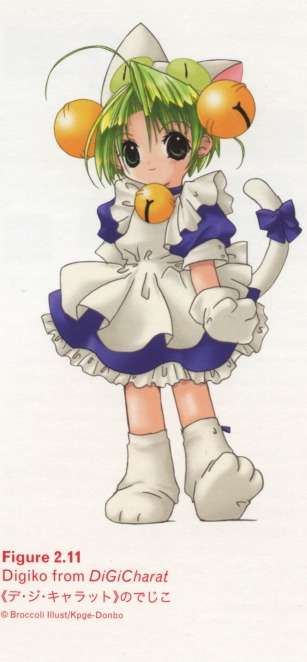
Figure top right: Digiko from DiGiCharat
TO: I think kawaii16 [literally, “cute”] is the concept Murakami-san exported throughout the world.
Granted, Murakami-san’s kawaii is alarming enough. But I wonder why I was further alarmed by Morikawa-san’s formulation of wabi-sabi-moe. In a previous conversation we had for a magazine article, you said, “Otaku is about the vector toward dame.”
As a way of expanding on that, when otaku choose this orientation, they head in the direction of becoming more and more pathetic. At the same time, they enjoy watching themselves becoming increasingly unacceptable. If you think about it, in a very, very loose sense, this is wabi and sabi.
I suspect this orientation is inherent in Japanese aesthetics. If you look for a Western equivalent, it would be Decadence, or the Baroque, though theirs is a tendency toward excessive decorativeness. I imagine such people think of themselves not in terms of “See what we’ve done. We’re amazing,” but more like, “See what we’ve done! How pathetic we are!”
TM: I have said this many times, but I am a “derailed” otaku.
Neither of your situations applies to me.
When I am talking to Okada-san, I remember feeling like I could never keep up with the distinctive climate of the otaku world.
So, I now want to explore the real reasons why I escaped being an otaku.
TO: Probably because otaku standards were so high when you tried to join them. Besides, I bet you wanted to go right to the heart of otaku, didn’t you?
The closer you tried to get to the heart of the otaku world, the farther you had to go.
TM: That’s not just true with otaku, though. The world of contemporary art is exactly the same. If you can’t discuss its history, you won’t be taken seriously and you won’t be accepted on their turf. I kept being reminded of this while listening to you two talk.
TO: In other words, just as you once had to know the history of contemporary art, now you have to understand moe, right?
[pg170]
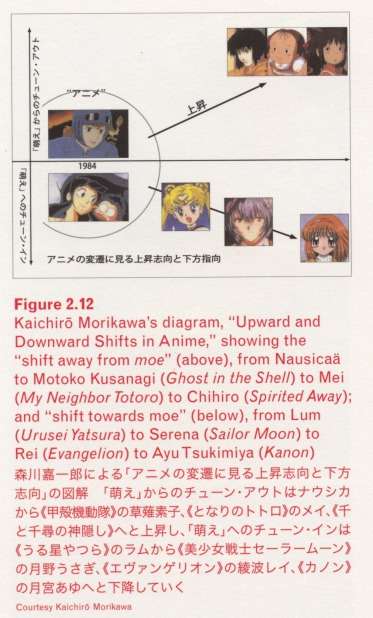
Figure top left: Kaichiro Morikawa’s diagram, “Upward and Downward Shifts in Anime”, showing the “shift away from moe” (above), from Nausicaa to Motoko Kusanagi (Ghost in the Shell) to Mei (My Neighbor Totoro) to Chihiro (Spirited Away); and “shift toward moe” (below), from Lum (Urusei Yatsura) to Serena (Sailor Moon) to Rei (Evangelion) to Ayu Tsukimiya (Kanon)
Otaku Vs Mania
Takashi Murakami: This may be a frequent question, but what is the difference between otaku and mania17?
Kaichiro Morikawa: In otaku studies, we often argued about this distinction. Generally speaking, three differences have been articulated.
First of all, mania are “obsessives” who are socially well adjusted. They hold down jobs and love their hobbies. In contrast, otaku are socially inept. Their obsessions are self-indulgent. This point is raised mainly by the self-proclaimed mania, critical of otaku.
The second point concerns what they love. Mania tend to be obsessed with, for example, cameras and railroads, which have some sort of materiality (jittai), while otaku tend to focus on virtual things such as manga and anime. In other words, the objects of their obsessions are different.
The third point relates to the second one. A mania tends to concentrate on a single subject—say, railroads—whereas an otaku has a broader range of interests, which may encompass “figures,”18 manga, and anime.
Taken together, I would say—although Okada-san may disagree with me—that someone who is obsessive about anime likes anime despite the fact that it’s no good, dame. That’s mania. But otaku love anime because it’s no good.
Toshio Okada: Mania is an analogue of otaku. Obsessives are adults who enjoy their hobbies, while otaku don’t want to grow up, although financially, they are adults. These days, you’re not welcome in Akihabara if you aren’t into moe.
I was already a science-fiction mania when otaku culture kicked in. I can understand it, but I can neither become an otaku myself nor understand moe. [Laughs]
T. Murakami: And I’m nowhere near Okada-san’s level. I failed to become an otaku. Period. [Laughs]
T. Okada: I believe otaku culture has already lost its power. What you find in Akihabara today is only sexual desire. They all go to Akihabara, which is overflowing with things that offer convenient gratification
[pg171]

Figure top right: Takeshi (left) and Yoshimi from DiGiCharat

Figure bottom right: Akihabara
[pg172]
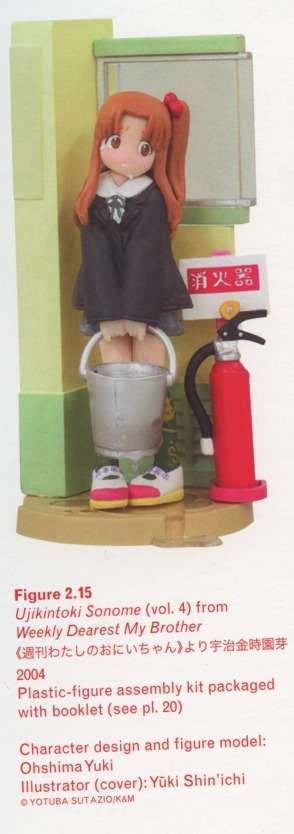
Figure top left: Ujikintoki Sonome (vol. 4) from Weekly Dearest My Brother 200421ya Plastic-figure assembly kit packaged with booklet (see pl. 20)
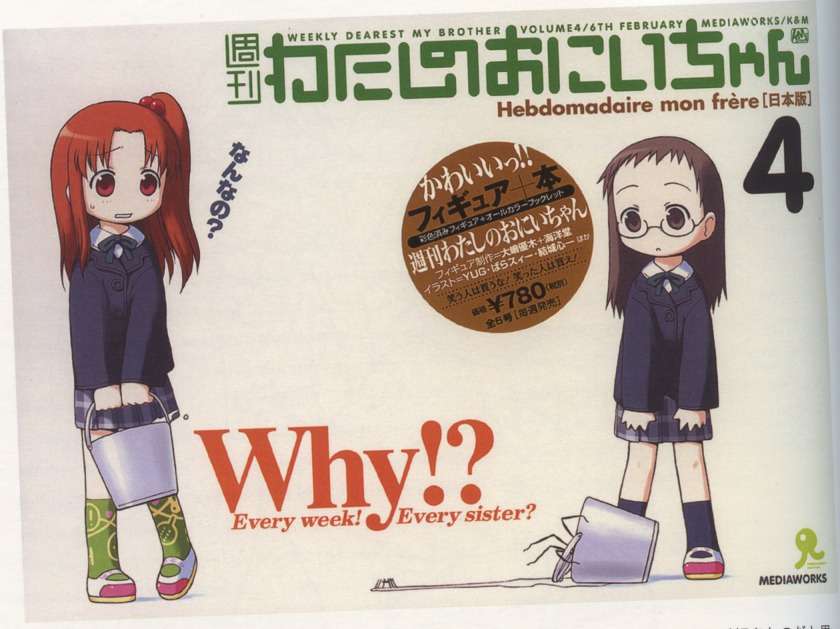
Figure top middle: Character design and figure model: Ohshima Yuki Illustrator (cover): Yuki Shin’ichi
of sexual desire, made possible by the power of technology and the media.
K. Morikawa: But I think the sexual desire in Akihabara is different from that in Kabuki-cho.19
TO: Kabuki-cho is about physical sex.
Because the heart of otaku culture shuns the physical, it has renamed seiyoku [sexual desire] as moe.
Sexual fantasies are becoming more and more virtual and “virtual sexuality” proliferates in Akihabara.
KM: Many otaku think they like what they like even though they know these things are objectionable, when in fact they like them precisely because they are objectionable. This gap between their own perception and reality has made it difficult to distinguish otaku from mania.
If we define otaku through this orientation toward the unacceptable, it’s easy to explain the three differences between otaku and mania. Because if you like something that’s socially unacceptable, you will appear antisocial.
Another consideration is that material things are considered superior to the immaterial. So if you are interested in the debased, you naturally gravitate
[pg173]

Figure top right: Sister Princess 2 200322ya PlayStation2 game
toward the virtual.
In addition, otaku don’t just purely love anime or manga, they choose to love these things in part as a means of making themselves unacceptable. That is why their interests are so broad.
This dame-orientation is evidenced by the history of otaku favorites. Up until the 1980s, people who watched anime—any kind of anime, be it Hayao Miyazaki20 or Mamoru Oshii21 or whatever—were all considered otaku. Today, Japanese anime is so accomplished that one film even won an Academy Award. As a result, grown-ups can safely watch, say, Miyazaki’s anime without being despised as otaku.
The upshot of this is, as soon as anime and games earned respectability in society, otaku created more repugnant genres, such as bishojo games22 and moe anime,23 and moved on to them.
TM: Morikawa-san, you’re saying the essence of otaku is their orientation toward dame, the unacceptable.
KM: Yes, yes. But dame does not define something as bad or low quality. It’s the self-indulgent fixation of otaku on certain things that is socially unacceptable.
TO: I totally disagree. Morikawa-san and I have two vastly different conceptions of who are the core tribe of otaku.
Morikawa-san, your otaku are “urban-centric”; they are the hopeless otaku who roam about Akihabara. That’s why you say otaku are dame-oriented. You have to remember that only about fifty thousand people buy Weekly Dearest My Brother.24 It’s wrong to define them as core otaku.
In my experience, otaku like science fiction and anime not because these things are worthless, but because they are good. Otaku are attracted by things of high quality.
Some otaku obsessions become hits, others don’t. But according to Morikawa-san’s definition, the question of “quality” becomes irrelevant in otaku culture.
But what’s survived in otaku culture hasn’t become unacceptable. It’s survived the competition because its quality has been recognized.
Once something like a bishojo game achieves a certain level of quality, you buy it even if you don’t actually like bishojo games. I feel otaku are tough
[pg174]
customers who demand high standards. As a producer of video and manga magazines, I was keenly aware of their standards and thought, “They make me work really hard because they won’t fall for cheap tricks.”
Generational Debate
Takashi Murakami: I have to confess, I don’t think I fully understand the moe sensibility.
Toshio Okada: The moe generation is mostly made of otaku 35 or younger.
I myself belong to the previous otaku generation, so frankly I don’t understand moe.
The generational shift is abrupt. Some people below a certain age know what moe is about. But those of us above that age can’t figure out why they like bishojo so much. It seems to us that they like anything involving beautiful young girls.
There is a general debate. The liveliest topic in the otaku world these past few years has been this generational debate.
Among themselves, otaku refer to belonging to this generation or that.
Kaichiro Morikawa: I’m not that interested in the generational debate. Once you have a clear definition of otaku, then you can have a generational debate. But there is no generally accepted framework for understanding otaku. So it’s futile to subdivide otaku
T. Okada: Morikawa-san, what is your definition of otaku?
K. Morikawa: If you track the central focus of so-called otaku through the generations, Okada-san’s generation focused on science fiction, followed by a generation that favored anime, which was in turn followed by another interested in moe anime and bishojo games. How did this evolution take place? Manga provide a handy example. Before I was born [in 197154ya], college students reading manga on the trains were considered a serious social problem.
Back then, manga were for children. Grown-ups were supposed to watch TV dramas. Foreign TV dramas were better than domestic ones, and films were even better than that. And European films were considered more sophisticated than Hollywood
[pg175]
movies. There was a clear cultural hierarchy, and manga were at the bottom. The spiteful label of otaku was attached to grown-ups who had unacceptable tastes and still enjoyed kids’ stuff.
As far as society is concerned. today’s otaku taste for moe is more repugnant than watching porn. Eroticism is not the only motivation that informs their fascination with moe. They have a strong urge for what is unacceptable.
Otaku who buy Weekly Dearest My Brother not only feel affection for toy figures, but also enjoy being the kind of people who “buy embarrassing, tasteless things.”
TO: Otaku are bashful. They are intelligent but so bashful that they’re more comfortable with children’s anime than with regular movies. They can shed their reserve if a serious idea is filtered through a “Made for Children” label. I suspect that people who love toys and figures, manga, and anime love them because they can see the world through this filter of reticence.
Otaku consume this stuff because of the twist that indulges their shyness.
At any rate, I have never seen an orientation toward the unacceptable among otaku.
For example, Space Battleship Yamato25 dates from the first half of the 1970s, followed by Mobile Suit Gundam26.

Figure left bottom: Sarin gas attack on Tokyo subway by Aum Shinrikyo, March 20, 1995
[pg176]
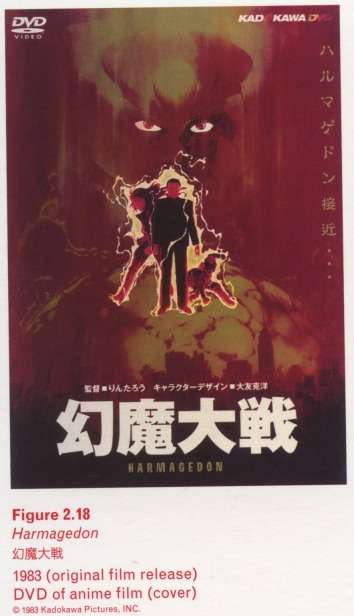
Figure left top: Harmageddon 198342ya (original film release) DVD of anime film (cover)
Now, Morikawa-san, would you say Gundam was more unacceptable than Yamato? I don’t think so.
The more examples I show you, the less solid your theory becomes.
KM: Well, let me repeat myself. Being no good, dame, doesn’t mean the quality is poor. On the contrary… the quality is very high, but it’s a matter of self-consciousness on the part of otaku. They are concerned that their self-indulgence appears socially unacceptable.
TO: Well, then, do you mean from the mid- to late 1970s, things got progressively more unacceptable from Yamato to Gundam, and then Nausicaa of the Valley of the Wind?27 I don’t think so.
An inclination for dame appears to exist because otaku have shifted to bishojo these past few years. Within this limited context, you may have a point, but veteran otaku have to disagree.
KM: Generally speaking, I see a downward spiral.
Aum Shinrikyo28 was influenced by Genma Wars.29 In the 1980s, otaku dreamt of Armageddon; they fantasized about employing supernatural powers to create a new world after the end of the world.
But Aum’s subway attack in 199530ya thoroughly shattered the post-apocalyptic otaku dream of creating a new world in which they would be heroes.
After their apocalyptic fantasies collapsed, they steadily shifted to moe. Before their Armageddon obsession, there was science fiction, which provided otaku with an alternative to the actual future. In the broadest terms, moe has replaced the “future”.
TO: But your definition of science fiction is narrow. In Japan, science fiction was viable as a literature of alternative futures only through the 1930s. From the 1960s onward, science fiction became socially conscious, a lens into alternative societies.
In Japan science fiction was associated with the future only during the brief period between World Wars I and II. As you know, Japan Sinks30 by Sakyo Komatsu, a blockbuster in 197352ya, wasn’t a story about the future. Futuristic science fiction never took off here.
[pg177]
T. Murakami: Morikawa-san, how do you define the “future”?
KM: The future is not merely a time yet to come. It’s a vision of the world based on scientific understanding.
TO: Again, that is true only through the 1940s. Even the visions of the future presented by Robert A. Heinlein and Isaac Asimov were discredited by the harsh attacks from the New Wave movement.31
Whether we’re talking about science fiction or anime, our views are so divergent. I don’t see things the way you do, Morikawa-san. Not at all.
KM: You mean, we have an unbridgeable gap?
TO: Not necessarily. I am sympathetic to your observation that Expo ’7032 prefigured an otaku landscape, and that today’s otaku are fascinated with moe. But as far as your definition of otaku is concerned, I think you are wrong. Because we are reading different “texts”.
TM: I’m beginning to see a crucial generation gap between Okada-san and Morikawa-san. Speaking from my generation, I, too, find otaku more compelling than moe.
TO: Murakami-san, I know you are preoccupied with otaku, but I don’t think otaku will generate anything more interesting than moe.
I belong to a group of model-tank makers. When I meet with them, I can’t tell them apart from the guys who obsess about moe. They carry backpacks and wear sweatsuits. They look like stereotypical moe enthusiasts, but you never know which toy figure—bishojo or model thank—they’re going to pull out of their backpacks.
If we refer to them as a “tribe”, they all belong to the same tribe, but the model-tank guys are never into bishojo. Actually, they hate bishojo.
KM: How are they different from mania?
TO: To answer your question, I have to go back to my own definition of otaku. The sole difference between mania and otaku is their social acceptability. Otaku are mania who are socially rejected. Conversely,
[pg178]
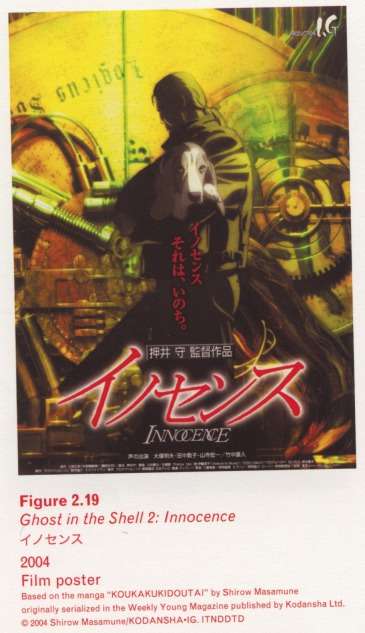
Figure top left: Ghost in the Shell 2: Innocence 200421ya Film poster
the hobbies of mania are those that are socially accepted.
For example, the moment girls decide that motorbikes aren’t cool, motorbike mania become motorbike otaku. It’s just a matter of societal labeling. That’s the only difference between mania and otaku.
KM: Doesn’t that mean they are oriented toward the unacceptable?
TO: No, it doesn’t. Even if a motorbike mania suddenly becomes a motorbike otaku, he doesn’t become an otaku because he is unacceptable. He only becomes unacceptable because society says he is.
Let’s use an extreme example. It’s possible that one day the Japanese people will suddenly be defined as unacceptable. Say we become the enemy of the world for some reason.
Would you then say we Japanese are inherently unacceptable? I don’t think so. It boils down to the question of societal labeling.
KM: In that case, let’s suppose that one day anime is legitimized and enters school textbooks. Would otaku obsessed with anime today still love anime then? I think not. That’s not plausible.
Okada-san, if we accept your definition, otaku should love anime regardless of how society values it.
If anime became so wonderful that schoolteachers recommended it to their students, would otaku still seek out anime? I seriously doubt it.
TO: I can prove you wrong. Some otaku works are socially accepted, others are not. Anime films by, say, Hayao Miyazaki or Mamoru Oshii are respected. Have otaku lost interest and quit watching them? No.
I don’t think societal labeling affects what they are attracted to. In fact, many otaku support Mamoru Oshii’s latest animated film, Ghost in the Shell 2: Innocence.33
Morikawa-san, when you talk about dame, the unacceptable, aren’t you talking about “literature” (bungaku)? For practitioners of jun-bungaku34 [literally, “pure literature”], literature was about becoming unacceptable. After Evangelion35 came out as a TV anime series in 199530ya, everybody fell in
[pg179]
![Figure top right: Masked Rider 1971–197352ya TV anime [??? –Editor] series](/doc/anime/eva/little-boy/otaku-talk/kamenrider.jpg)
Figure top right: Masked Rider 1971–197352ya TV anime [??? –Editor] series

Caption bottom right: Five Rangers 197550ya Tokusatsu film
love with dame.
Until then, literature was relevant only within the realm of pure literature. Some rock musicians may have liked it a bit. But, thanks to Evangelion, ordinary people, young people enthusiastically embraced it. Eva made it OK for the main character to be pathetic. By the standards of conventional anime, it’s inconceivable that Eva’s main character doesn’t try harder. But that’s precisely what makes him so appealing today. While literature used to shock and surprise us in the past, anime shocks and surprises us today. A dame-orientation is not a new thing; in the old days, a dame-orientation was called literature.
KM: Don’t you think Gundam got a similar reception? The main character was a computer geek.
TO: In Gundam, one thrust of the story was the main character’s desire to be recognized by others. So Gundam and Eva are completely different.
KM: As I said before, the 1980s-era fascination with the apocalyptic was shattered by Aum. I think moe emerged as an alternative, to fill the void.
TO: I see. To me, Eva was all about “Since I can’t do anything about changing the world, I will do something about myself.” Don’t you think “robot anime”36 is all about “trying to change the world”?
Morikawa-san, you talked about the apocalyptic. One step before that is “social reform” (yo-naoshi). One of the key concepts for understanding otaku is “a child’s sense of justice”. The reason grown-ups are enthusiastic about Kamen Rider37 and the “warrior team” genre (sentai mono)38 is because that basic sense of justice, which we abandoned in society long ago, is still meaningful in the world of these TV shows.
Of course, there’s also the terrific monster designs and pan-chira [the fleeting display of girls’ panties], but that’s not enough to keep the boys interested. That basic sense of justice worked until Eva. But with Eva, it became clear that no one could save the world. And Eva complicated the whole thing, raising issues such as “Maybe I should at least save myself” and “What’s wrong with me, thinking only”
[pg180]
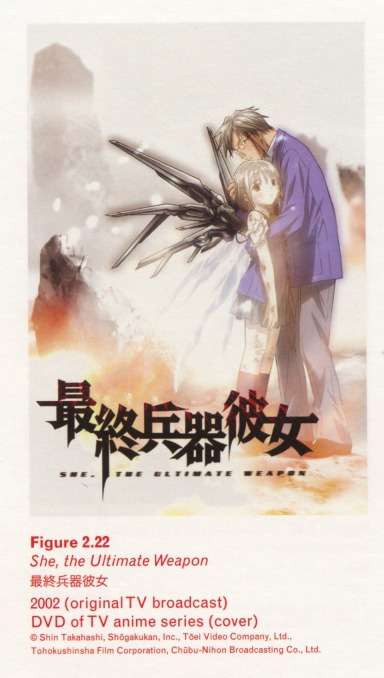
Figure top left: She, the Ultimate Weapon 200223ya (original TV broadcast) DVD of TV anime series (cover)
“about saving myself?” Eva marked a turning point. Whatever we discuss today, we cannot avoid Eva.
KM: After Eva, a genre called sekai-kei [literally, “world-type”] emerged, and it’s very popular now. In this genre, private feelings and emotions are directly linked to the fate of the world.
TO: She, the Ultimate Weapon39 is the definitive sekai-kei.
KM: And Eva.
TO: Reading just a couple volumes of She, the Ultimate Weapon will give you a sense of the sekai-type sensibility.
In the typical logic of sekai-kei, the same weight is assigned to one’s private emotions and the end of the world. In She, the world comes to an end. The main character witnesses the annihilation of the world, which happens to be caused by his girlfriend. His love for her and his despair over the destroyed planet are expressed through the same emotion.
But making a sekai-kei ends artists’ careers.
KM: You mean, like Hideaki Anno,40 who created Eva?
TO: That’s right. Anno-san has been in rehabilitation ever since [by getting away from anime and working on live-action films].
By Way of Conclusion: Otaku And Art
Takashi Murakami: While listening to you, it dawned on me that otaku is much like Pop in the art world. There are many kinds of Pop, each of which is generationally defined.
The otaku Okada-san believes in is comparable to the serious medium of “painting” in art, while the otaku defined by Morikawa-san is akin to my work, as a “failed otaku”.
Toshio Okada: Right. Murakami-san, you marketed shokugan41 [literally, “food toys”] last year. I think the toy figures of Weekly Dearest My Brother are far more otaku than yours, precisely because you are a failed otaku. Their work is more creative, whereas your shokugan are very commercial. If you ask me
[pg181]
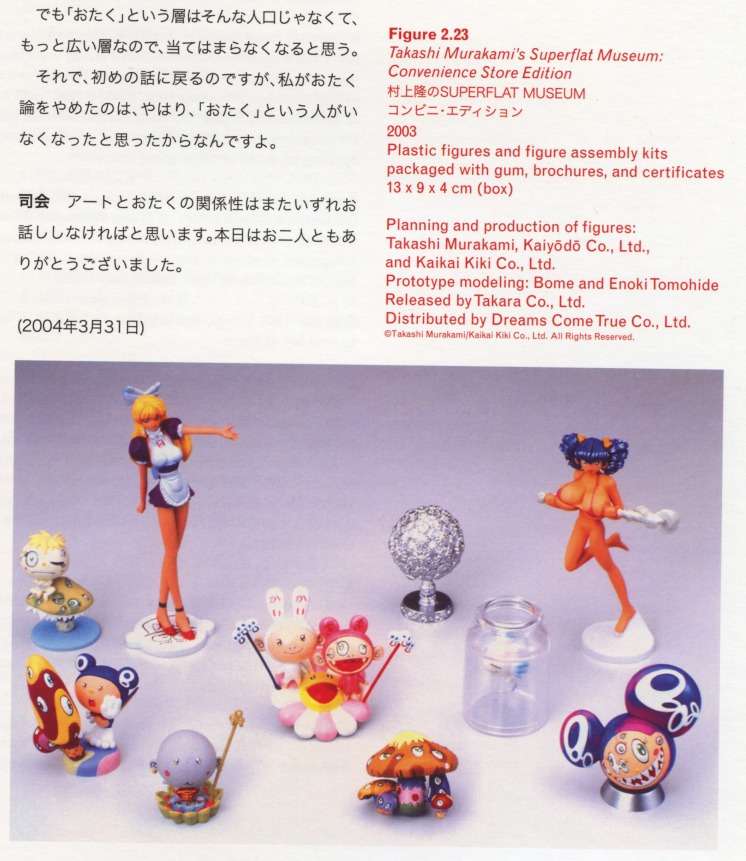
Figure right bottom: Takashi Murakami’s Superflat Museum: Convenience Store Edition 200322ya Plastic figures and figure assembly kits packaged with gum, brochures, and certificates.
which is “art”, I would say those of Weekly Dearest My Brother.
But the problem is that your work is more recognized socially as art—which makes it so hard for me to understand art.
T. Murakami: In today’s discussion, a few things became clear: the huge gap between those who know moe and those who don’t, as Morikawa-san told us; the generational debate among otaku; and the three different positions we have—that is, I am in art; Okada-san, in otaku; and Morikawa-san, in moe.
Kaichiro Morikawa: Okada-san, I don’t know if it’s a fair categorization, but generationally speaking, your otaku experience was from a time when people respected otaku for their achievements.
I had the opposite experience, belonging to the generation that suffered otaku-bashing.42 In our discussion, I emphasized the unacceptability of otaku, and you said I was “completely wrong”. I wonder if this reflects our contradictory experiences.
T. Okada: For argument’s sake, let’s assume you define otaku as the self-proclaimed fans of gyaruge43 and bishojo figures, who are about thirty or younger today. If you say this group of people have such and such dame-orientation, I would have to agree.
But I don’t think otaku are limited to this group. Otaku encompass many diverse types. That’s why I can’t agree with you. And this brings me back to my initial statement, which is that I quit otaku studies, because I thought that there were no more otaku.
TM: We’ll have to reconvene some other day to discuss more about the relationship between otaku and art. Morikawa-san and Okada-san, thank you so much for today’s discussion.
(March 31, 200421ya)
The translator wishes to thank Toshio Okada, Kaichiro Morikawa, and Yoshiyuki Mashimo for their assistance in compiling the notes.
-
The term otaku signifies “obsessed fans, primarily of anime and manga.” First introduced to the print media by the critic Akio Nakamori in 198342ya, the word defies any simple (or simplistic) definition. While the word otaku sometimes carries a derogatory connotation in Japan, it can have a positive meaning as a Japanese loanword in the West, signifying knowledgeable or hardcore fans of anime. For its etymological origin, see Noi Sawaragi’s essay in this volume.
-
The word dame (pronounced “dah-me”) originated in the Japanese game of go, signifying spaces of no benefit to the player claiming them—ie. useless spaces. In contemporary idiomatic Japanese, this versatile word variously means “no good,” “worthless,” “incompetent,” “unacceptable,” “pathetic,” or “inept.” [“What is argot, properly speaking? Argot is the language of misery.”]
-
Established in Osaka in 196461ya, Kaiyodo is a pioneer in shokugan (literally, “food toys”) and “figures” (see note 18).The company initially worked with confectionery manufacturers, but since 198243ya it has devoted much of its business to developing original products. These now amount to some two thousand different items, ranging from “capsule toys” featuring characters from Evangelion to those of the natural history series Aqualand and Dinoland.
-
The Great Hanshin Earthquake struck the region between Kobe and Osaka early in the morning on January 17, 199530ya. More than 6,000 people died, with more than 43,000 injured and nearly 320,000 evacuated. In an earthquake-prone country, it was one of the most devastating single events, comparable to the Great Kanto Earthquake in 1923102ya, which destroyed much of Tokyo and its environs.
-
Gamera is a tokusatsu (special effects) monster-film series featuring a gigantic mutant tortoise (kame in Japanese, and hence the creature’s name, Gamera). The original Gamera cycle consisted of eight movies produced 1965–15198045ya, with a second series of three movies appearing 1995–4199926ya. In each installment, Gamera wreaks havoc on Tokyo and other Japanese cities while battling an array of other giant monsters.
-
At 764 meters, Mt. Mihara crowns Mt. Oshima, located on Izu Oshima Island south of Tokyo. When the volcano erupted in November 198639ya, the island’s entire population, some ten thousand altogether, evacuated the island within a day, as the flowing lava rapidly encroached upon residential areas.
-
In the 198936ya film Godzilla vs. Biollante, Godzilla appears from behind Mt. Mihara.
-
The term moe originated in a computerized transcription error, when the character meaning “to burst into bud” (moeru) was substituted for the homonym meaning “to catch fire.” Moe in otaku jargon denotes a rarefied pseudo-love for certain fictional characters (in anime, manga, and the like) and their related embodiments. For further detail, see Otaku: Jinkaku = kukan = toshi /
Otaku: Persona = Space = City / Otaku: Personalita = spazio = cittaa, exhibition catalogue packaged with a figure (Tokyo: Gentosha, 200421ya). -
The presentation of Otaku: Persona = Space = City at the Japanese pavilion of the Venice Biennale’s Ninth International Architecture Exhibition (September-November 200421ya) was organized by commissioner Kaichiro Morikawa. It included works by the architect Kenzo Tange, the otaku critic Toshio Okada, the company Kaiyodo, and others.
-
The best-known bishojo is Usagi Tsukino (Serena in the U.S. version) of the popular TV anime series Sailor Moon (first broadcast in Japan in 199233ya). Her full title in Japanese is bishojo senshi, or “pretty-girl warrior.” Moe-type bishojo (such as the ten-year-old Digiko of DiGiCharat, a 199926ya TV anime series) are generally young, innocent-looking girls.
-
Arata Isozaki (b. 193194ya) is a leading architect-theorist who represents Japan’s avant-garde and postmodern architecture. He designed the Museum of Modern Art, Gunma (197451ya) and the Tsukuba Civic Center (198243ya), among others; and created Electric Labyrinth for the 196857ya Milan Triennale. He is Artistic Director of 2005: International Triennale of Contemporary Art.
-
Organized by Arata Isozaki, the exhibition MA: Space-Time in Japan was first presented at the Museum of Decorative Arts in Paris in 197847ya. Under the thesis, “Ma is the place in which a life is lived,” as articulated in the accompanying catalogue (the English edition published by the Cooper-Hewitt Museum), Isozaki visualized different manifestations of ma (literally, “space”) in Japanese culture through diverse installations.
-
Akihabara is a huge electrics and electronics shopping district in Tokyo. Long dominated by household-appliance stores, Akihabara began to change in character in the 1990s, when large-scale stores specializing in personal computers and related products prompted its diversification, which in turn drew younger customers to the area. The rapid infiltration of otaku culture beginning around 199728ya completely changed the face of Akihabara. Kaiyodo was a pioneer in this transformation, moving its stores from the fashionable Shibuya district, and was followed by other stores specializing in commercial and privately made merchandise related to anime, manga, and games, such as doujinshi (fanzines) and character-based products.
-
“Shibuya is a district of Tokyo controlled by the Sezon and Tokyo groups, companies that promote a fashionable and sophisticated urban lifestyle through their consumer products. As such, the whole town has become a gigantic advertisement.” (Morikawa)
-
Eroge is an abbreviation for “erotic games.” It is a subcategory of bishojo games (see note 22) that includes sexually explicit, adult content, and is thus unavailable to people under the age of eighteen. The most representative eroge is To Heart.
-
For kawaii in contemporary Japanese art and pop culture, see Midori Matsui’s essay in this volume.
-
In Japan, a person who has a fanatical enthusiasm for or interest in something is called mania, derived from the English “maniac.”
-
“Figures” (pronounced figyua in Japanese) are a counterpart of American “action figures,” broadly encompassing plastic representations of popular characters from anime, manga, and games.
-
Kabuki-cho is an area no more than a few hundred meters square, northeast of Shinjuku’s subway and railroad hub in Tokyo. In addition to many small restaurants and bars, it is crowded with massage parlors and other purveyors of sex.
-
Hayao Miyazaki is an anime artist, film director, manga writer, and founder of the anime company Studio Ghibli. He first made his name with his manga Nausicaa of the Valley of the Wind (1982–94) and its cinematization in 198441ya. Often centering on such themes as the conflict of nature vs. science and technology or the destruction and rebirth of civilization, he has created such popular anime films as Princess Mononoke (Mononoke-hime, 199728ya) and Spirited Away (Sen to Chihiro no kamikakushi, 200322ya), which won the Academy Award for best feature-length animated film.
-
Mamoru Oshii is an anime creator and director. He directed the TV anime series (198144ya) and cinematization (198243ya and 198342ya) of Urusei Yatsura by Rumiko Takahashi, the anime science-fiction film Ghost in the Shell (Kokaku kidotai, 199530ya), and the live-action film Avalon (200124ya), among others.
-
Bishojo games have two categories: eroge (“erotic games”; see note 15) and gyaruge (“gal games”). While the former include sexually explicit content, the latter do not. It should be noted, however, that the labeling criteria vary from manufacturer to manufacturer, depending on the intended medium for the game software (ie. a computer or a “game machine” such as PlayStation and Game Boy).
-
Exemplars of the moe-anime genre are DiGiCharat (199926ya; see note 10) and Love Hina (200025ya).
-
Released in 200421ya, Shukan watashi no onii-chan /
Weekly Dearest My Brother is a series of boxed sets, each containing a bishojo-centered comic booklet and a figure. These depict the lives of girls attending a fictional private elementary school; figures are produced by Kaiyodo. To date, six different boxes have been issued in total. -
Space Battleship Yamato (Uchu senkan Yamato; broadcast in the U.S. as Star Blazers) was a breakthrough TV anime series, first broadcast in Japan in 197451ya. See pl. 27 and Sawaragi’s essay.
-
Mobile Suit Gundam (Kido senshi Gandamu), first broadcast in 197946ya, was a TV anime series that spawned a long line of sequel series. See pl. 30.
-
Nausicaa of the Valley of the Wind (Kaze no tani no Naushika; modified and released in the U.S. as Warriors of the Wind) first took form in 198243ya as a serialized manga epic (serialized through 199431ya), created by Hayao Miyazaki (see note 20), who went on to direct the 198441ya film based on the manga. Princess Nausicaa, who grows up in a safe haven insulated from the polluted world a thousand years after a great war, uses her intellect, heart, and courage to protect everything she loves.
-
For Aum Shinrikyo, an armed cult group that released deadly Sarin gas on Tokyo subways, see Sawaragi’s essay.
-
Genma Wars (Genma taisen), a story about people with supernatural abilities who fight Genma (Phantom Demon) to protect the Earth, originated as a series of books by Kazumasa Hirai. The novels were adapted by Shotaro Ishinomori as manga, and were subsequently made into an anime film in 198342ya (released as Harmagedon in the U.S.).
-
For the science-fiction novel Japan Sinks (Nihon chinbotsu), see Sawaragi’s essay.
-
“New Wave science fiction, characterized by its philosophical bent, arose in the late 1960s and early 1970s. Representative writers include J.G. Ballard in the U.S. and Koichi Yamano in Japan.” (Okada)
-
Expo ’70, held in Osaka in 197055ya, was the first World’s Fair in Asia. Under the theme of “Progress and Harmony of Mankind”, it featured a wide range of technological triumphs as well as projections for the future—from space technology (the U.S. pavilion exhibited a moon rock and an Apollo spacecraft) to a monorail, moving sidewalks, and electric cars, to computer-linked information services.
-
Oshii’s Innocence (200421ya, released as Ghost in the Shell 2: Innocence in the U.S.) was nominated for the Cannes Film Festival in 200421ya.
-
“As opposed to popular and mass literature, jun-bungaku (pure literature) aspires to achieve the purity of art, eschewing popular tastes and a wider reception. Within Japan’s literary establishment, jun-bungaku often means the ‘I’ novel, which focuses on the author’s private experiences and feelings. Representative writers of jun-bungaku include Yukio Mishima and Osamu Dazai.” (Okada)
-
Evangelion, commonly known as Eva, is shorthand for the TV anime series Neon Genesis Evangelion (Shin-seiki Evangerion, or “New Century Evangelion”), first broadcast in 1995–96, and its cinematization (199728ya), both created by the anime studio Gainax. See pl. 33.
-
“Robot anime” is a popular genre of anime that features powerful or otherwise extraordinary robots as protagonists or the central theme of the story. The very first robot anime was Astro Boy (Tetsuwan Atom), which was also the first anime TV series in Japan, broadcast in 196362ya. In recent years, robot anime has become “giant robot anime”, the most representative example of which is Mobile Suit Gundam (see pl. 30).
-
Masked Rider is a TV special-effects series, first broadcast in 1971–73. The heroics of the title characters, who are “altered humans” battling against the evil organization Shocker, have been perpetuated by spin-off Riders in subsequent series, which continue to this day,
-
The “warrior team” genre, which originated in the special-effects TV series Himitsu sentai Gorenja, or “Secret Team of Five Rangers” (released in the U.S. as Mighty Morphin’ Power Rangers), has enjoyed tremendous popularity in Japan since Gorenja was first broadcast in 197550ya. The “team” concept, derived from the “double riders” scheme of Masked Rider, customarily allows the inclusion of one female fighter.
-
She, the Ultimate Weapon (Saishu heiki kanojo) originated in 200025ya as a serialized manga by Shin Takahashi (translation published as The Last Love Song on This Little Planet). It was made into a TV anime series in 200223ya, and adapted as a game in 200322ya.
-
Hideaki Anno is a screenwriter and director whose best-known work is the TV anime series Neon Genesis Evangelion and its cinematization (se pl. 33). After Evangelion, Anno shifted his interest from anime to live-action films, and in 199827ya directed the feature film Love & Pop, based on Ryu Murakami’s novel; he created his first special-effects scenes in his 200421ya film, Cutie Honey.
-
Contemporary shokugan originated in gangu gashi (literally, “toy candy”), first introduced in 1922103ya, which were candies packaged with small toys and targeted at children. In 199926ya, the shokugan boom was launched by Furuta’s “Choco Egg”, a chocolate shell containing elaborately detailed plastic animal and insect figures manufactured by Kaiyodo, which set the standard for things to come. The extremely high quality of today’s shokugan has made them objects of adult—and otaku—fascination, as demonstrated by Murakami’s shokugan series, Superflat Museum (200322ya).
-
In 198936ya, a landmark event turned otaku into a household word: the serial murders of young girls by Tsutomu Miyazaki. When the ever-curious mass media discovered that the alleged murderer’s room was filled with numerous volumes of manga and thousands of videotapes of anime and other genres of popular culture, the whole nation was stunned by his obsessive nature. The world otaku was closely associated with Miyazaki’s profile—a weirdo unable to form meaningful relationships with grown women or distinguish reality from fantasy. The mass media went on the attack against otaku, and children interested in anime and games were frequently harassed and ostracized at school.
-
Gyaruge is an abbreviation of “gal games”. It is a subcategory of bishojo games (see note 22) that does not contain sexual content, and is thus available to people under eighteen. The most representative example is Tokimeki Memorial.